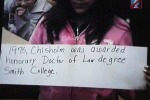Over the last month, we have had several different types of connections. And have connected with many different places. As a result, I have learned a lot about videoconferencing. Here are some of the things I have learned.
Visuals
For the African-American Fact or Fiction conferences, it was a requirement that they have a visual of their clue so that they other class could easily write it down, or at least that was the thought behind it.
One of the things I learned is that this requirement leaves a lot to the imagination. 🙂 We had visuals that ran the gamet in quality. Some were typed, some handwritten, some on flip charts and others in powerpoint. Also, the mode of displaying these were diverse. Some were hand held, others set on a stationery object, some used the document camera, while others were on the computer.
What I found that works the best are the following:
- Typed in a LARGE font size, 72 pt or larger.
- Using a stationery object is prefered. Either some kind of stand that the visual can be placed on or using a document camera.
- List only one clue per visual. A list of the clue is too hard to read.
- In all of the above cases, it is important to ZOOM in so that the clue can be seen clearly. This should be done with a preset so as not to make the remote site sea sick. 🙂
- While PowerPoint works, there is a tendency to put too much on it so the font size is not big enough. Also, people tend to leave it on the presentation and we never get to see the students.
- And more of a “techie” thing than a instructional thing, but I’m not a big fan of Duo Video or H.239. I’ve only seen it work really well in one situation. Most of the time, it just seems to mess things up, and the other side can’t always see it. I would much rather just change the input for the main video.
Here are some examples. You can decided for yourself what you think works well. Click on a thumbnail for a larger version.
Audio
The placement of the mic is essential. Most people place the mic in the center of the room thinking that this is the best location. However, the mic that we have, actually has a “front” and “back”. If the student is in front of the mic, they are heard fine. If the student is behind the mic, their audio is muffled and sometimes barely audible.

The best place for the mic is on a chair or table towards the front of the room, facing all of the students. In most cases, this is sufficient for most students to be heard when talking in a normal voice. However, if a student is soft spoken, they may need to be moved closer to the front of the room.
Changes for next year for the Fact or Fiction program
This was the first year for this program and as such I think it went really well. But there are a few things that I think could be improved upon.
- Make sure the person being featured is communicated beforehand so that the classroom teachers is able to gather appropriate resources and credible research links.
- Give examples of good clues. The best clues seemed to be date related or truly based on fact. Just the way some of the clues were written, left the answer up for debate.
- Ban the use of wikipedia. While you can get a lot of good information there, you can’t count that it is always accurate.
If you participated in this project, I would love to hear your feedback.











